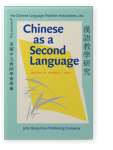Vol. 54:1 (2019) ► pp.31–50
Differentiating and teaching the Chinese near-synonyms kongpa and pa
Previous research and data from learner corpora show that Chinese language learners have a hard time differentiating kǒngpà (恐怕) and pà (怕). However, there has been little research analyzing the differences between the two words. Therefore, this study aims to distinguish kǒngpà and pà when both words denote worry toward a probable event. Adopting the corpus-based analysis approach, the researchers explain the semantic and pragmatic differences between kǒngpà and pà. Based on the research findings, the researchers propose discovery-oriented activities and drill practice to guide students to use the two words correctly. The researchers further argue that research findings from corpora data should be included in textbooks and integrated into Chinese language instruction.
Article outline
- 1.Introduction
- 2.Literature review
- 3.Research method and data collection
- 4.Results
- 4.1Semantics
- 4.2Pragmatic functions
- 5.Pedagogical implications
- Exercise 1.Debate competition
- Exercise 2.Role play
- 6.Conclusion
- Acknowledgements
- Abbreviations
-
References
